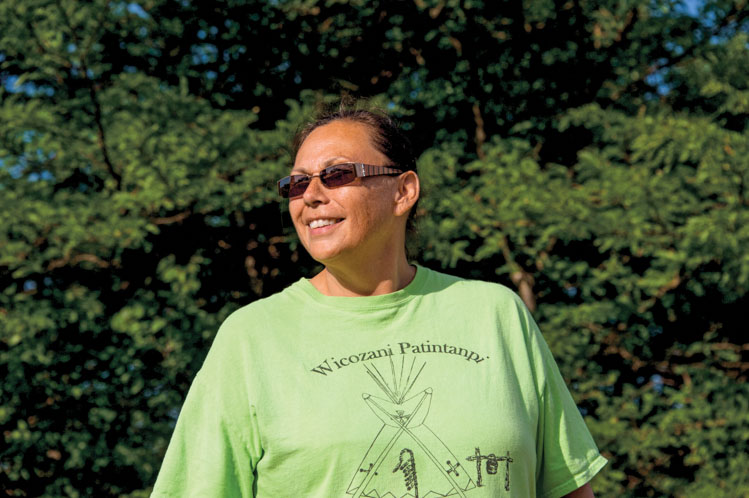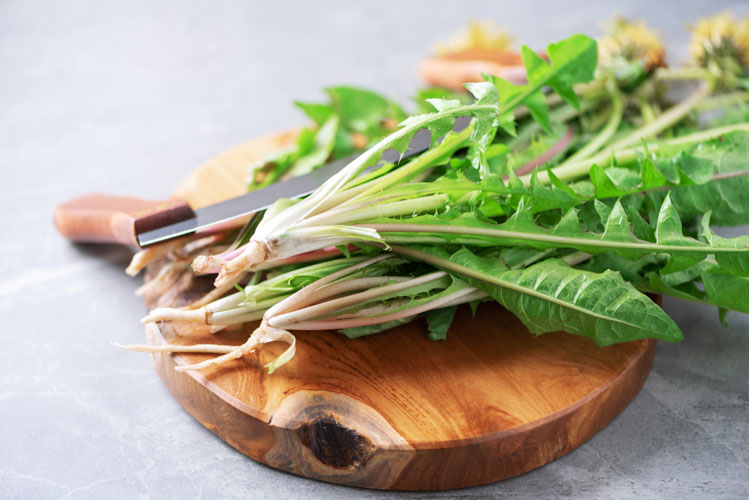The Gift of South Dakota
Subscriptions to South Dakota Magazine make great gifts!
Subscribe today — 1 year (6 issues) is just $29!
The Wonder of Dandelions
 |
| Marla Bull Bear helps manage summer camps on the Rosebud Reservation designed to connect teens with their Lakota roots. |
Dandelions are a scourge for people who think of beautiful city lawns as a monoculture of green rectangles. But the yellow flowers are like most things in life; the better you know them, the more you like them.
“Dandelions are absolutely amazing,” says Marla Bull Bear, a Herrick woman who often teaches youth about the wonders of nature in South Dakota. “It’s a plant that’s seen as a noxious weed until we realize how wonderful they are as a medicine and health benefit. That is what really got me interested in dandelions.”
“The entire plant is useful, as well as being extremely healthy,” says Bull Bear, who serves as executive director of the Lakota Youth Development. “The flowers are good in tea, the leaves can be used in any type of salad. And the roots can be used as a poor man’s coffee.”
Bull Bear roasts the dandelion roots, grinds them, and uses the grounds to supplement her coffee, making it last longer. People with a sensitivity to caffeine can use the dandelion roots as a complete coffee replacement. “To me, the grounds taste like dandelions,” she laughs. She describes it as a rich, earthy taste.
She uses the yellow flower to steep tea. It results in a mild taste, especially when sweetened with honey.
Once people open their minds to dandelions being a part of their diet, the benefits are almost overwhelming. Dandelions are more nutrient dense than lettuce, spinach, broccoli and other greens. They have a long tap root which pulls minerals from deep within the earth. Even dandelions grown in poor soil are still full of nutrition. To name some health benefits, dandelions are high in iron, vitamin A, B, C, K and E, calcium, copper, magnesium, potassium, zinc, antioxidants and fiber. In fact, dandelions are so hardy and nutritious that some families survived on them during the Great Depression.
Dandelions are also believed to have medicinal uses. Their milky juice can treat fungal infections on skin. The roots and greens are natural detoxifiers and diuretics, supporting the kidneys and liver and also the gallbladder. Dandelions may lower blood pressure and even calm your nerves.
If the numerous benefits of dandelions inspire you to start foraging, Bull Bear has a big disclaimer. It isn’t safe to eat dandelions that grow on a lawn sprayed with chemicals or pesticides. “Plants absorb chemicals out of the earth. So when lawns have been exposed it can take three to four years for the effects to leave,” she says. And even if your own lawn hasn’t been sprayed, chemicals can spread from nearby lawns through pollinators or the air.
“We have horrible mindsets about our lawns. And most lawns could feed a family for a year if we turned them into gardens,” she says. “We would all be healthier if we got out and dug in the dirt and got some sunshine. Our health issues and the earth are all connected. If we are being unhealthy with the land and our environment, it will come back to haunt us,” she says.
Even country dandelions, growing far from city lawns, may not be safe to harvest. Bull Bear asks that foragers avoid road ditches due to car exhaust and chemical sprays that may drift from neighboring fields and pastures. Even dandelions that grow by lakes and ponds may be problematic. “If the river or creek floods there are all manner of things in the flood water that can contaminate plants.”
Part of Bull Bear’s work with Lakota Youth Development is to teach kids about safe foraging and having respect for the land. “When we work with our youth here and think about plants it’s about building relationships between them and the plant nation. ‘What can it do for us?’ and ‘What harm can it do?’ It’s like making a relationship with people. And we can help them and benefit from what gifts they have to offer.”
Once you find an area that has untouched dandelions, foraging can begin. Bull Bear has three rules of thumb. The first is to never harvest more than you need, which is a guessing game for beginners. Second, never harvest more than one third of the plant in a given area so you leave the system strong. And finally, she recommends making an offering, a prayer or thank you, to the plant nation.
Dandelions are not a part of Native American folklore or legend. They were originally brought here by the pilgrims who knew the many benefits. “It’s a fairly new plant as far as Lakota history. But that doesn’t mean it’s not on our list of medicines,” Bull Bear says.
Bull Bear has seen many kids enjoy dandelions. “Every child is drawn to them. To pick them by the handfuls to give to grandma, or to make a wish while blowing their seeds. It has a real attraction for kids. If we want to get kids interested in foraging and their natural environment, dandelions are a great first plant.”
 |
Dandelion Tea
1 tablespoon of rinsed and drained yellow dandelion petals
1 cup hot water
Add honey to taste
Let steep 2-3 minutes
 |
Dandelion Flower Cookies
1 cup coconut oil
1 cup honey
4 eggs
2 teaspoons vanilla or almond (optional)
2 cups oatmeal
1 cup rinsed yellow, dandelion flower petals
2 cups flour
Mix all together. Drop by tablespoons onto a greased baking sheet and bake at 375 degrees F for 10-15 minutes. Let cool before serving.
 |
Dandelion Greens
4 tablespoons butter
1 onion
4 tablespoons flour
2 cups heavy cream or half and half
4 handfuls of rinsed dandelion leaves (either young leaves or older, longer leaves work well in this recipe).
Steam dandelion greens and drain. Chop onion and saute in butter (or olive oil). Brown flour in butter and onions, then take off heat and slowly stir in
milk. Stir over low heat until thickened. My husband loves basil so I usually sprinkle in a bit of basil at this point. Next add the dandelion greens and
cook for 5-10 minutes. This dish is good with a little shredded cheese sprinkled on top.
Editor’s Note: This story is revised from the March/April 2023 issue of South Dakota Magazine. To order a copy or to subscribe, call (800) 456-5117.










Comments